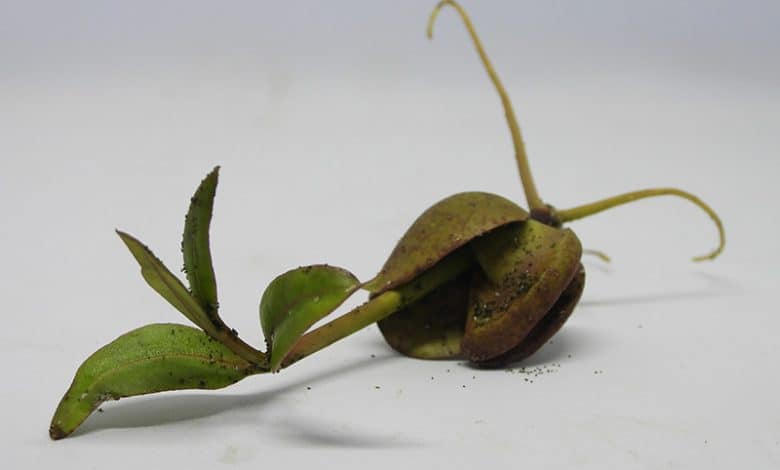
Researcher in the history of science
There is no plant that has puzzled ancient and modern people, such as mangrove. It was unique in life on the shores of the salt seas, opinions differed in its origin, and coastal communities and colonial nations competed to harvest it. Research into the history of Mangrove requires us to follow the geological history of its environment, the ancient geography of the seas and oceans, and the changes that have occurred in the ancestors of Mangrove over time, in order to reach the relationship of man with it, from the first centuries of its existence on Earth until now.
Origin of the Mangrove
Scientists believe that the oldest species of
Mangrove originated in the Indo-Malayaan territory. This theory is supported by the fact that there are more Mangroven species found in that region than anywhere else in the world. Because of the unique floating shoots and seeds of many mangrove species, early mangroves spread, moving west by ocean currents to India and East Africa, eastward to the Americas, and reaching Central and South America during the Late Cretaceous and Early Miocene (66 to 23 million years ago). This may explain why mangrove forests in the Americas contain fewer endemic species, while mangrove forests found in Asia, India and East Africa contain a full range of mangrove species.
Differentiation between Mangroven species
To understand the state of Mangrove throughout the geological history of the planet, it is important to know and understand how and where the different species of this plant evolved. As many authors have pointed out, the current distribution of Mangroven species predicts a clear differentiation between species found on the coasts of the Old World (in the Western Pacific, Indian Ocean, and East Africa) and those found in the New World (the Atlantic coasts of West Africa and the Eastern Americas). This differentiation can only be explained by historical processes. Most fossil evidence shows that the genera of modern Mangrove, or its closely associated ancient ancestors, originated in the late Cretaceous period (about 80 to 100 million years ago) along the shores of the Mediterranean Sea, which was formerly part of the Tethys Sea, which during the first, second and third geological times covered extensive sites of the Levant, Iraq, Turkey, Iran and the present-day Mediterranean. There is likely to be more than one mangrove epicentre. The two species known as Rhizophora and Mangroven (or Shura) known as Avicennia originated in the eastern region of the Tethys Sea. The species Nypa (called the Mangroven palm), and possibly the white Mangroven Laguncularia racemosa as well as the Conocarpus originated in the western region of this sea. The species: Sonneratia, Heritiera, Pelliciera and Black Mangrove Aegiceras originated in the coasts of the central region of that sea.
A group of Mangroven families developed independently of their terrestrial ancestors during the late Cretaceous-Paleocene period. This was confirmed by the oldest fossils, which belong to the Mangroven palm (Nipa), which is 75 million years old. Genomic and fossil evidence suggests that the mangrove palm (Nipa) evolved from other palm trees 72.1–83.6 million years ago, and that another species of mangrove, Acrostichum fern, diverged during the late Cretaceous period 66.0–88.1 million years ago.
The Mangroven tea plant (Plesiera) and the extinct Mangroven Brevitricolpites also date back to the late Cretaceous period. The common Mangroven genus, known as Rhizophora, originated from 47.8 to 54.6 million years ago, coinciding with the maximum average climate temperature of the Paleocene and Eocene eras. It is assumed that the ancestors of Mangrove were submerged due to sea level rise during that warm period, and these plants became able to adapt to tidal conditions. Mangrove plant strains increased steadily during the tertiary period (66 to 2.58 million years ago) to about 100 species. For example, Xylocarpus may have evolved from their terrestrial ancestors about 19.4 million years ago, and Acanthus mangroves evolved about 16.8 million years ago.
From the late Cretaceous to the mid-Eocene the world was warm, most of the earth was covered with forests, and there were no ice caps in the polar regions, which was ideal conditions for mangrove forests to develop, and flourish. During that time, mangroves became widespread along the shores of the Tethys, Atlantic and Pacific Oceans. Fossil pollen records suggest that these trees stretched north across the Mediterranean to what is now the United Kingdom, France, and possibly elsewhere in Europe. Fossil evidence of the main mangrove species that originated around the ancient Tethys Sea has been found, and the Aikat populations of these trees may have been divided by the closure of this sea after continental erosion. Later, this erosion helped some Mangroven species expand their existence; the Rhizophora expanded eastward with the erosion of the Indian tectonic plate, and Australia separated from Antarctica and moved north. The transmission of Mangrove by the erosion of continental plates is the reason for similar global distributions of some Mangroven genera, despite significant differences in the individual dispersion capacity of each genera.
The distribution of mangroves may have expanded during the warm Eocene period; for example, the mangrove Avicennia was found in Siberia (at latitudes above 72° north) during the Middle Early Eocene. The distribution of mangroves decreased when global average temperatures decreased during the Oligocene and Miocene, and its area decreased as its tree populations declined in colder climates, such as in the late Eocene period, when mangrove forests gradually shrunk south of Europe and north from some of the upper latitudes of the southern hemisphere. Continental drift over 18 million years led to Africa's connection with West Asia, the closure of the sea route between the Tethys Sea (now the Indian Ocean) and the Atlantic Ocean, and the separation of mangroves found in the "Old World" from those of the "New World". Finally, around three million years BC, the closure of the Isthmus of Panama, which effectively connected North and South America, separated the mangrove plants on the east coast of the Pacific Ocean from those on the west coast of the Atlantic.
Although global patterns of mangrove species diversity preceded the Pleistocene era, events of this era influenced the global climate and sea levels, ultimately modifying existing mangrove distributions in different regions of the world. During the dry periods of the Pleistocene era, the Mangroven species was more associated than today with the hot, humid climate of the equator. In addition, the decline in sea level, which has been associated with glacial events in the Pleistocene period, has created extensive land links between some Mangroven species.
Mangrovein the modern era
There are two main factors that control the distribution of mangrove in the world during the modern
era (Holocene). These two factors are: climate and relative sea level rise. As is the case today, the presence of mangroves was only primarily associated with tropical and subtropical latitudes through climatic controls. Although the full cadastral extent of mangroves during the Holocene is unknown, sea level and the influence of geomorphological factors had a significant impact on the distribution of mangroves. At the height of the last ice age, sea level was 120-130 metres below the current level. The early Holocene era was marked by naval abuses of this level in some areas, which was reflected in the world's mangrove sites.
Regional differences have had a clear impact on the vulnerability of mangrove forests to sea-level rise, particularly in areas closest to the ice sheets during the last ice age, such as Florida and the Caribbean. This influence depends on the interaction between surface change processes (e.g. sediments and accumulation of organic matter) and the relative rise in sea level. Mangrove sank when the relative rise in sea level exceeded the appropriate limit, as occurred during the early Holocene era.
7000–5300 years ago, there was a slowdown in the rate of sea-level rise, and thus the relative impact of sediment accumulation increased, facilitating the filling of estuaries, creating a vast intertidal zone that enabled mangroves to keep pace with sea level rise. Less than 5,300 years ago, the floodplains dominated by mangroves became filled with grass and papyrus, and mangroves receded to the shores of estuaries.
Prehistoric
use of Mangrove From the mid to late Holocene the rate of human use of Mangrove's resources decreased, due to the change in sea level. 6,500 years ago, ancient humans used Qandal (Red Mangroves) charcoal in their trade. Around that time, Bedouin communities in the Middle East settled around the coasts and chose areas near mangroves to live in, as the subsistence economy relied on wood and shellfish. Throughout history, coastal communities have continued to use Mangrove, and their trade in it has spread over the past few centuries. Mangroven timber trade routes have been established between East Africa and the Middle East for centuries. This may have led to the degradation of mangroves in areas where it has been heavily felled, and may have had some impact on the area of the Mangroven Aykat in several locations around the world.
Mangroves in the writings of the ancients
Perhaps the first historical description of mangroves that has come to us is that written by Nearchus, the Greek admiral of Alexander the Great's fleet, in 325 BC. In his chronicles of Nearchus he described mangroves in the Red Sea, the Arabian Gulf and the Indus Delta. Twenty years later (in 305 BC), Theophrastus, Aristotle's disciple, also referred to mangroves in his Survey of Plants: "But there are plants in the sea that they call 'bay' and 'olives'. On the tidal islands, they say that large trees grow, the size of a bear tree or the tallest poplar..." Theophrastus also spoke about some of the medicinal benefits of Mangrove, stating that its seeds and seedlings (of the type of rhizophora) were eaten as a sexual tonic. This was confirmed by the Moroccan vegetarian Ibn Abbas in 1230 AD, who added that medicinal substances are extracted from it to treat gum disease and liver diseases.
In the era of the prosperity of Islamic civilization (from 1000 to 1300 AD), historians mentioned that the mangrove bark (of the type Rizophora) was frequently used in tanning and dyeing processes. Mangroven wood was also used in the manufacture of furniture and boats due to its resistance to wood mites.
Mangroves before Columbus
Mangroves played an important role in the lifestyle of many coastal communities, and these trees were closely associated with human civilization. In India, the Solomon Islands and Kenya, the sites of Mangrove are seen as sacred places where temples are built for their trees. In Latin America, the importance of Mangroven habitats in indigenous cultures is illustrated by animal archaeology data, which support cultural anthropological inferences about prehistoric life and environment. Before Columbus arrived in the New World, indigenous peoples in the Americas used mangroves extensively for timber, charcoal, tannins (for tanning leather), collecting oysters (in their habitat), and fishing (sheltering to their roots). Organisms that dot the mangrove environment often represent a large biomass accessible from the ground and can be easily collected and harvested or caught with simple techniques (by hand, fencing and traps). This has led to the production of a stable source of animal protein and to the promotion of population growth and settlement of human populations. The coastal culture of Valdivia (Ecuador) dates back to the early formative period (1800 BC – 200 AD) and is evidence of large-scale fishing of marine fish and molluscs from mangrove habitats, as well as of hunting birds nesting in mangroves (such as ibis, ducks and waterfowl).
At the beginning of the transition from nomadic to sedentary living, Mangroven habitats are believed to have played a key role in this stability. The fertility and diversity of low-lying coastal lands adjacent to mangroves may provide a suitable place for hunter-gatherer communities on Ecuador's coast, where they have begun to grow edible plants. Evidence of pre-Columbian indigenous peoples' use of Mangroven resources has been found in the eastern tropical Pacific region.
Between 700 BC and 500 AD, the civilization called Tumaco/Tolita, which flourished in the area between Buenavantura (Colombia) and Esmeraldas (Ecuador), was based on harvesting the products of the Mangroven environment from mollusks, fish, crabs, birds and marine mammals. Communities belonging to that civilization and settled in that area before the arrival of Columbus benefited from fish living in the Mangroven environment.
Mangrovein the New
World The first Spanish historian to describe the mangrove forests on the American continent was Gonzalo Fernández de Oviedo, in 1531 AD in his book (General and Natural History of the Andes), he wrote: "Mangrove is the best tree in these lands, and it is widespread in these islands (Greater Antilles) and in the province of Tierra Ferm (most of which is located in the Isthmus of Panama). Mangrove wood is one of the best wood available for the construction of shelves, columns and supports of houses, fences, interior frames, doors and other small things... The bark of these mangroves is uniquely good for tanning cowhide in a short time."
Some coastal communities living in the Americas before Columbus used Mangrove for many construction and heating purposes. In the early stages of the colonization of the New World, the Spanish intensified their exploitation of Mangroven wood and used it in construction work, especially shipbuilding, because of its water-repellent properties, hardness and length of trunks. The harvesting of Mangroven timber played an important role in the construction and leather industry, and Mangroven coal was used in sugar production. For these reasons, Mangrove has become part of the tax or "tribute" that indigenous communities have to pay to the King of Spain.
During the seventeenth century, the Spanish were keen to expand their maritime range, encouraging the construction of shipyards in the strategic coastal cities of Ecuador, Costa Rica, and Panama. These ponds required large quantities of mangrove wood. The Spanish monarchy claimed that the shipyard in Guayaquil (the largest city in Ecuador) was the most important shipyard on the Pacific coast of the Americas because of the quality of the ships constructed in it. Between the sixteenth and mid-eighteenth centuries, the demand for timber for the shipyard and the construction of churches and buildings in Lima (the capital of Peru) was so high that the Mangroven columns exported from the Pacific Ocean to Colombia reached six thousand columns a year. Mangroven timber was also exported from Ecuador to Peru to build coastal cities such as Lima, due to the lack of forests in Peru. Jorge Juan and Antonio de Ulloa reported how mangrove was exploited in Ecuador in their book Secret News of America, published in 1747: "In construction and repair work they use large quantities of mangroves that the Spanish king takes annually from Guayaquil... The loss of mangroves is rising to very large amounts."
The demand for Mangroven timber was so high that the Spanish monarchy issued regulations for the exploitation of that timber, which required those who wished to do so to obtain special permits for the cutting of certain species of Mangrove. Mangrove logging activity continued without supervision or discipline for many years without any replanting of these trees.
The exploitation and marketing of Mangrove reached industrial levels after 1948, when two companies located in Buenaventura monopolized the production of tannins, which are used industrially in tanning animal skins and making ink, which is produced from Mangroven foreskin, for the next thirty years. By the sixties, they were harvesting about 3,000 tonnes of mangrove per month, mostly from red mangroves. By the seventies, the exploitation of mangrove wood in Colombia in construction and tannins extraction reached its peak, and later collapsed for two reasons: the first was the decline in prices in Colombia due to the international market for tannins (tannins), and the other was the increase in the rates of deforestation of mangroves for the manufacture of tannins.
They used large mangrove logs to make power line poles and railway beams. For more than 400 years, large profits have been the primary motivation for the felling of mangroves, causing widespread deforestation. Mangroves from many sea coasts have become extinct in recent decades. In Kuwait, for example, in the forties, these trees were found on the seashore in the areas of Khuwaisat and Kazma. Linda Shoaib mentions in her book (Kuwait Wild Flowers) "Mangroves were wooded from the shores of Khuwaisat, and sold inside the wall of Kuwait for use as fuel in the mid-forties and before."
Kuwaiti historian Farhan Abdullah al-Farhan mentions in his Dictionary of Places, Sites and Places in Kuwait that the ancient Kuwaitis "used to bring their ships from Kuwait City, and their ships would dock on the coast adjacent to Jabal Ghadi, and then they would go down with their food and donkeys to wood in this area to take mangroves and acacia trees." Jabal Ghadi is 14 kilometers east of Kazma.
Mangrove's resources in modern times
The transition from a subsistence economy to the industrial use of Mangrove's resourceswas associated with the colonial management of world wealth during the period from the eighteenth to the early twentieth century. In the Americas, Spanish colonialism in the fifties organized the harvesting of Mangrove because the high demand for timber for shipbuilding led to overharvesting of its trees. Mangroven protectorates were also established by German colonization in East Africa in the nineteenth century to compete with the timber trade in Europe.
Southeast Asia has a long history of exploitation and management of Mangrove, with colonial powers establishing forest reserves in the nineteenth and early twentieth centuries to produce timber and charcoal. By the nineteenth century, mangroves had been removed for coconut cultivation, as happened along the Caribbean coast of Colombia. Evidence suggests that mangrove forests in many parts of the tropics were beginning to suffer from the removal of their aikats, which led to their significant degradation. In some locations, there has been a balance between mangrove cutting and growth, leading to the expansion of mangrove forests in some countries such as New Zealand.
The scholarly literature on Mangrove between the seventeenth and twentieth centuries focused mainly on the description of the morphology of the Mangroven plant, its habitat, the distribution of its forests, the diversity of its species, and its scientific classification. From about 1900 onwards, studies focused on the ecological role of mangroves. In the second half of the twentieth century, the first public initiatives for the conservation of mangroves began after some studies revealed their economic value due to their role in enriching the food web. As a result, our perceptions of Mangroven systems have changed, instead of being a wasteland made up of unhealthy soil, we see them as complex ecosystems on which humans depend.
At present, the removal of Mangrove is associated with aquaculture, agriculture and urban land use. Access to mangrove timber continues to cause the degradation of remaining forests, despite new threats including solid waste disposal, pollution, sea level rise and overfishing.




